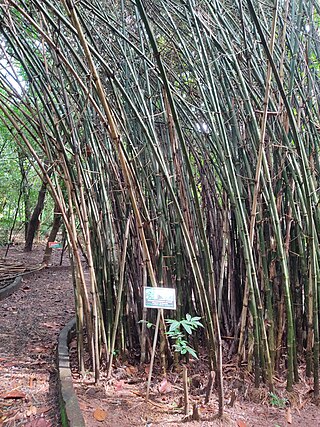
Sri Lanka, formerly known as Ceylon and officially the Democratic Socialist Republic of Sri Lanka, is an island country in South Asia. It lies in the Indian Ocean, southwest of the Bay of Bengal, separated from the Indian peninsula by the Gulf of Mannar and the Palk Strait. Sri Lanka shares a maritime border with the Maldives in the south-west and India in the north-west.

The pygmy killer whale is a poorly known and rarely seen oceanic dolphin. It is the only species in the genus Feresa. It derives its common name from sharing some physical characteristics with the orca also known as the killer whale. It is the smallest cetacean species that has the word "whale" in its common name. Although the species has been known to be extremely aggressive in captivity, this aggressive behavior has not been observed in the wild.

The Sri Lanka blue magpie or Ceylon magpie is a brightly coloured member of the family Corvidae, found exclusively in Sri Lanka. This species is adapted to hunting in the dense canopy, where it is highly active and nimble. Its flight is rather weak, though, and is rarely used to cover great distances. In spite of the Sri Lanka blue magpie's ability to adapt to the presence of humans, it is classified as vulnerable to extinction due to the fragmentation and destruction of its habitat of dense primary forest in the wet zone of southern Sri Lanka.

Myrmarachne is a genus of ant-mimicking jumping spiders that was first described by W. S. MacLeay in 1839. They are commonly called ant-mimicking spiders, but they are not the only spiders that have this attribute. The name is a combination of Ancient Greek μύρμηξ, meaning "ant", and ἀράχνη, meaning "spider".

The Sri Lankan shrew, also called Gordon's pygmy shrew, is a species of mammal in the family Soricidae. It is endemic to Sri Lanka. It is threatened by habitat loss. It is known as හික් මීයා in Sinhala. It was named after the wife of A. C. Tutein-Nolthenius, Marjory née Fellowes-Gordon, who collected specimens of the shrew and provided them to Phillips.
Wildlife of Sri Lanka includes its flora and fauna and their natural habitats. Sri Lanka has one of the highest rates of biological endemism in the world.

Pseudoxytenanthera is a genus of Asian bamboo in the grass family native to India, Sri Lanka, and Indochina.
- Pseudoxytenanthera bourdillonii(Gamble) H.B.Naithani – India
- Pseudoxytenanthera monadelpha(Thwaites) Soderstr. & R.P.Ellis – India, Sri Lanka, Laos, Myanmar, Vietnam
- Pseudoxytenanthera ritcheyi(Munro) H.B.Naithani – India
- Pseudoxytenanthera stocksii(Munro) T.Q.Nguyen – India, Vietnam
Scrotochloa is a genus of Asian, Australian, and Papuasian plants in the grass family.

Eremochloa is a genus of Asian and Australian plants in the grass family.
Antimimistis attenuata is a moth in the family Geometridae. It is found in Sri Lanka, north-eastern Himalaya, Borneo, Sulawesi, Seram and New Guinea. Records from Queensland refer to Antimimistis illaudata which is sometimes listed as a synonym of Antimimistis attenuata.
Diospyros attenuata is a species of tree in the ebony family, Ebenaceae. It is endemic to Sri Lanka. This tree has been found to occur in only three forest reserves during the extensive National Conservation Review forest surveys.
Gynnidomorpha attenuata is a species of moth of the family Tortricidae. It is found in Sri Lanka.

Microlepia is a genus of ferns in the family Dennstaedtiaceae described as a genus in 1836. Most of the species are native to Asia, with many endemic to China, although a few species occur also in Australia, Africa, the West Indies, Latin America, and various oceanic islands.

The genus Oxytate, commonly known as grass crab spiders, comprises a homogenous group of nocturnal crab spiders. The complete mitochondrial genome of the type species O. striatipes was determined in 2014.

Helga's Folly is an art nouveau boutique hotel situated in Kandy, Sri Lanka owned by Helga de Silva Blow Perera, daughter of Fredrick de Silva. Gregory Peck, Peter Finch, William Holden, Mahatma Gandhi, Vivien Leigh, Laurence Olivier, Jawaharlal Nehru, and Kelly Jones of the Stereophonics are some of the notable guests who stayed at the hotel. Jones went on to write and record the song "Madame Helga" after his stay at the hotel. Helga's Folly has been described as "insane, kind of creepy, but awesome at the same time."









